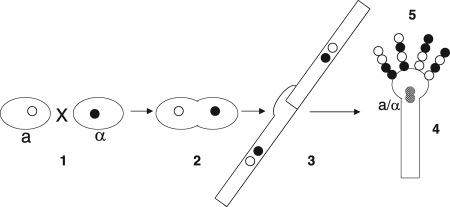FIG. 1.
Sexual development of C. neoformans. Large ovals represent yeast cells. Black and white circles represent a and α nuclei. (Section 1) Under appropriate environmental conditions, yeast cells of opposite mating types sense one another via pheromones and pheromone receptors. (Section 2) Yeast cells fuse, but their nuclei do not. (Section 3) After fusion, a new developmental program occurs, leading to dikaryotic, filamentous growth. (Section 4) In response to unknown signals, filamentous growth arrests, a basidium is formed, and nuclear fusion takes place. (Section 5) Meiosis and sporulation result in four chains of spores that reside on the surface of the basidium.

